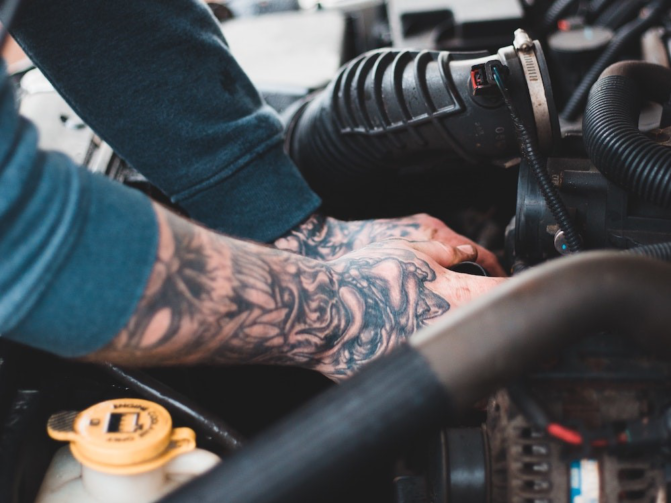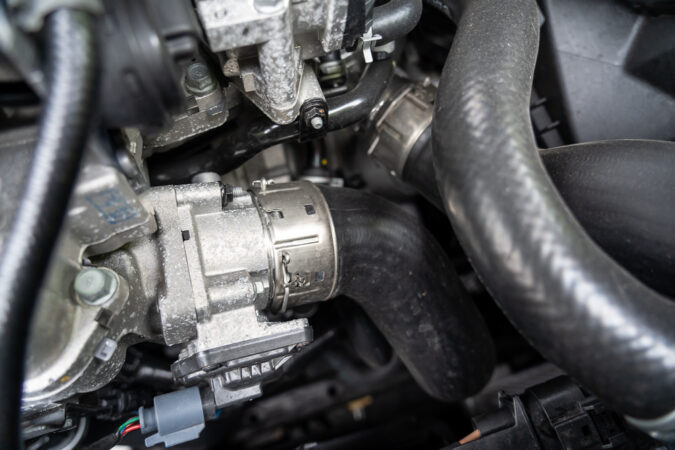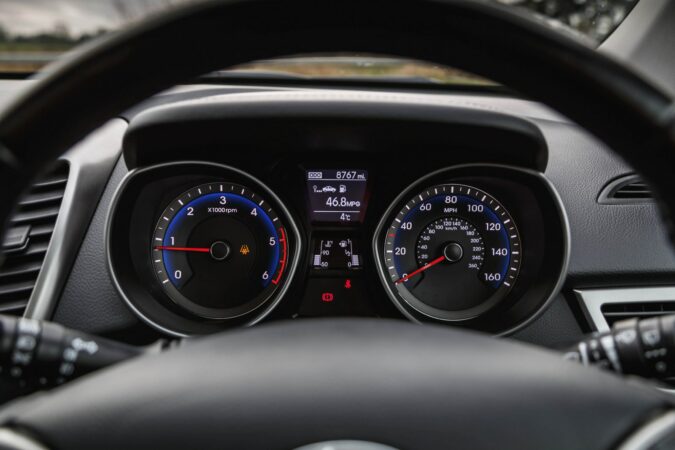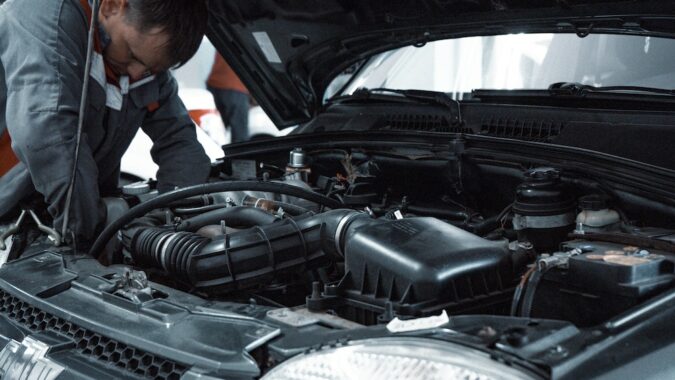Your car’s engine is supposed to idle at a steady RPM, usually somewhere around 600 to 1000rpm depending on your car’s make and model. If you’re experiencing idling issues, we often assume that something’s wrong with the ignition, fuel system, or even the engine’s internals. But here’s one part we don’t often talk about: the idle air control valve.
This post will be your ultimate guide to the idle air control valve (IACV). From what it is and how it works, signs that it has gone bad, and replacement costs along with everything else you need to know. Here’s the table of contents to help you quickly navigate:
How The Idle Air Control Valve Works
So, what does the idle air control valve do, and how does it work? As the name suggests, the idle air control valve controls the amount of air to let into your engine while it’s idling. It works together with your car’s throttle body, here’s a more in-depth explanation:
Your car’s engine runs by burning fuel and air inside the cylinders. When you press on the gas pedal, the car’s engine control unit (ECU) opens the throttle body to allow more air to enter the engine. Meanwhile, the fuel injectors squirt more fuel into the engine, and voila! More fuel and air means you get more power.
When you lift off the gas pedal, the throttle body closes and cuts off the air supply. However, your engine still needs air to run at idle, and this is where the idle air control valve comes in: it opens automatically to allow air to enter the engine, essentially bypassing the throttle body.
The valve takes information from several sensors. And if the ECU detects that you’re going to idle, it opens the valve to allow air to enter so that the engine won’t stall.
The fuel system doesn’t need a bypass valve since modern cars use either direct or port injection, where fuel is injected into the engine and doesn’t have to mix before reaching the engine like in the days of carburetors.
Not All Cars Have An Idle Air Control Valve
Keep in mind that not every fuel-injection car has an idle air control valve. Instead, some cars simply manipulate the opening of the throttle body. The need for the valve depends on what type of throttle body the car has. While there are multiple types, we can break them down into two major types: drive-by-cable and drive-by-wire.
A drive-by-cable throttle body means the throttle body’s operation is done by a cable that’s physically connected to the gas pedal. In this case, it needs an idle air control valve since the ECU can’t manipulate the throttle’s opening – it simply depends on the driver’s input on the gas pedal.
Meanwhile, a drive-by-wire throttle body (often called an electronic throttle body or ETB) is operated electronically. In other words, there is no physical connection between the gas pedal and the throttle body. In this case, the ECU takes information from the throttle position sensor (TPS) to operate the throttle body.
Since it’s electronically controlled, it can manipulate the opening of the throttle body. If the ECU thinks that the engine is about to idle, it will slightly open the throttle body to let a small amount of air in, just enough to keep the car idling. As a result, it doesn’t need a bypass valve to keep the engine idling.
Most cars from the last decade use an electronic throttle body. However, some still use a drive-by-cable system, especially cheaper entry-level cars. Check with your owner’s manual to find out, or you can Google it and there should be plenty of information on what type of throttle body your car has.
Bad Idle Air Control Valve Symptoms
Unlike a lot of other engine components, the idle air control valve doesn’t have a service or replacement interval. But it will go bad over time due to wear and tear, and here are the symptoms to look out for:
1. Abnormal Idling Behavior
First and most obviously is that your car will idle in a weird way. As mentioned, a car typically idles between 600 – 1,000rpm, maybe at 1,100 in some cars when the air-conditioning is on. Note that during cold starts, it’s perfectly normal for the engine to idle at a higher RPM for the first couple of minutes, but it should drop afterward.
However, if your car continues to idle high (or too low), or it doesn’t hold a steady RPM, then this could be caused by a faulty IACV. The IACV may open or close erratically, leading to an unsteady air supply which results in a rough idle.
Keep in mind that there are other things that can cause a rough idle, such as a clogged fuel filter, faulty fuel injectors, or worn-out spark plugs. These things can cause engine misfires, which often results in rough idling and hesitation when accelerating. We’ll discuss more on how to diagnose later on.
2. Engine Stalling
A faulty IACV can also cause your engine to stall when idling. As mentioned, the engine may idle too low if the IACV is faulty. An engine usually needs to be at least around 600rpm to maintain operation. If the rpm drops too low, it will shut down.
It may also shut down because the IACV isn’t opening when necessary, which cuts off the air supply into the engine. Much like us humans, an internal combustion engine will die if it doesn’t get air.
There are several potential causes for an engine stalling, but if it’s caused by a faulty IACV, this will usually happen when the engine is idling or when you’re coming to a stop. If the engine stalls when you’re driving, then you’re looking at a different problem.
3. Check Engine Light
Since the IACV is part of the engine, it can trigger a check engine light if it’s faulty. A check engine light means your car’s On-Board Diagnostics (OBD) system has registered a trouble code. This trouble code means the ECU knows something is wrong, and it’s warning you of the problem through that check engine light.
If there’s a check engine light, you can scan the OBD system with an OBD scanner to find the trouble codes that’s been registered. Keep in mind that this is true if you have an OBD-2 system, present in all cars since 1996.
The trouble code won’t tell you exactly what’s wrong, but it helps to narrow it down and makes the diagnosing process easier. Watch the video below on how to do it, or read our guide on how to use an OBD scanner to learn more.
In the case of a bad idle air control valve, the scan will usually return either a ‘P0505’ or ‘P0506’ code, sometimes both. This is a universal code and it indicates that there’s something wrong with your IACV.
As mentioned, this won’t tell you exactly what’s wrong. This code can mean the IACV isn’t opening or closing properly, or it could also mean that it’s dirty and is disrupting airflow into your engine. Additionally, it can also mean that you have a vacuum leak that causes a rough idle.
There are also tons of other codes that can be triggered by a rough idle. Take note of the trouble codes you’re seeing and can check with a trouble code list to see what they mean. If you don’t see the P0505 or P0506 code, then there’s something else wrong with your car. But if you see those codes, then here’s how to troubleshoot it:
Troubleshooting Idle Air Control Valve
Now, IACVs can be quite expensive to replace. So, before you spend hundreds of dollars replacing it, let’s learn how to troubleshoot the problem and make sure that you actually need to replace it.
Keep in mind that these troubleshooting steps are going to be useful if you see the P0505 or P0506 codes. If you see a different trouble code, then you’re going to need a different solution depending on the trouble code that you have.
1. Checking For Vacuum Leaks
Your car’s engine has several vacuum hoses, and they’re there to maintain pressure within the engine. This allows the fuel and air mixture to ignite at the proper time. If a vacuum hose is leaking, they won’t be able to maintain this pressure.
As a result, your engine will misfire which can lead to a rough idle. Keep in mind that if the P0505 code is triggered by a vacuum leak, the misfire should continue as you drive along. Meanwhile, if the misfire only happens during idling, this is more likely to be an IACV problem.
Regardless, before you replace the IACV and shell out hundreds of dollars, there’s no harm in checking the vacuum hoses first. They cost around $50 – $100 each to replace, much cheaper than replacing the IACV.
The video above from Eric the Car Guy is a great guide on how to check for vacuum leaks. Here’s a quick guide:
- Visually inspect the car’s vacuum hoses. Replace them if you see physical damage.
- A popular checking method is to spray carburetor cleaner onto the vacuum hoses. However, this can be a fire hazard, so be very cautious. Do it while the engine is cold, and have a fire extinguisher nearby.
- Turn on the engine.
- Spray the carburetor cleaner to areas where the vacuum hoses connect to.
- If the engine’s idle fluctuates or it shuts off completely, then that’s where your vacuum leak is coming from.
If you can’t find a vacuum leak, then your vacuum hoses are fine. This means the problem lies with your IACV:
2. Checking The Idle Air Control Valve
Now we’ve established that the problem is with your IACV, not the vacuum hoses. The first and simplest thing you can do is to disconnect and then reconnect the IACV’s electrical connection:
- Locate the IACV. You should be able to find this information in the owner’s manual or by doing a quick Google search for your specific make and model.
- Some cars may have the IACV inside the air intake tube, which means you will need to remove it before you can access the IACV. Removing this is usually a matter of undoing several screws and clamps.
- Disconnect the IACV’s electrical connection and reinstall the air intake tube if necessary.
- Turn on the engine, let it idle for a few minutes, then turn it back off.
- Reconnect the IACV connection, then turn on your engine. See if the idling problem persists.
What this does is resetting your car’s ECU setting for the IACV. If this didn’t help, then either the IACV is dirty and clogged, or its internal components are broken. This brings us to our next step:
3. Cleaning The Idle Air Control Valve
Cleaning the IACV requires you to remove it. If you don’t like working on your car, you’re probably better off replacing the IACV and saving you the trouble of having to work on it twice. But if you don’t mind, cleaning the IACV can help you avoid a costly replacement job.
This is a general guide for cleaning the IACV, and there might be specific steps that you need to do depending on your car’s make and model:
- Locate the IACV. Again, some cars may require you to remove the air intake tube before you can access it.
- Afterward, disconnect the electrical connection and other hoses that connect to the IACV.
- Remove the bolts holding it down and then remove the IACV. The IACV’s connection to the throttle body usually has a rubber gasket, make sure you don’t lose them.
- Hold the IACV and make sure the mechanical components are facing up.
- Spray a throttle body cleaner to clean the carbon deposits (if you know how to clean throttle body). Then use a Q-Tip or a brush to clean the insides. Spray it once again to flush the dirt out after brushing.
- Wipe it clean, and put the IACV back on the throttle body.
- Tighten the bolts and screws. Some cars may have a torque spec for the bolts, so you’ll need a torque wrench.
- Reconnect the electrical connection.
- Reinstall the air intake tube if necessary.
- Start the car and see if the idling problem persists.
The video above from ChrisFix should give you a better idea of how to clean the IACV. If your car now idles fine, then you’re good to go! The check engine light may linger afterward, but it should go away on its own after a while. If the light persists, check our guide on how to reset the check engine light.
Idle Air Control Valve Replacement Cost
If the idling problem still persists after cleaning, then it’s like its internal component is broken and you’re going to have to replace the IACV altogether. So, how much is it to replace the IACV?
The parts cost varies greatly depending on your car’s make and model, it’s usually somewhere between $70 – $400 for most cars. Labor will add another $80 – $120 depending on the shop’s labor rates and how easily accessible the IACV is.
The cost comes mostly from the parts, and if you want to save money, you can replace the IACV yourself:
Idle Air Control Valve DIY Replacement
The steps are largely similar to cleaning the IACV, here’s how to do it:
- Locate the IACV. Some cars may require you to remove the air intake tube before you can access it. Checking your owner’s manual or doing a quick search will help you find it.
- Remove the air intake (if necessary) then disconnect the electrical connection and other hoses that connect to the IACV.
- Remove the bolts holding it down and then remove the IACV.
- Clean the throttle body by using a throttle body cleaner and a brush, then wipe it clean – this step is optional but recommended.
- Place the new IACV on top of the throttle body. The rubber gasket may already be installed on the IACV, or you may need to place it on top of the throttle body. Check with the manual to be sure.
- Tighten the bolts and screws for the IACV. Some cars may require you to tighten the bolts to a certain torque spec.
- Reconnect the electrical connection for the IACV.
- Reinstall the air intake tube if necessary.
- Start the car and see if the idling problem persists.
- Reset the check engine light if it doesn’t go away on its own.
The video above shows how to replace the IACV on a 2004 Suzuki Forenza, where it requires you to remove the air intake tube before you can access the IACV. In some cars, this may not be necessary and you can immediately access it.
There are plenty of tutorial videos on Youtube, and you should be able to find one that can help you with your car’s make and model. However, the general steps are the same. Good luck!
Idle Air Control Valve FAQ
Got any more questions about the idle air control valve? Here are some answers you might find helpful:
Can I Drive With A Bad IACV?
You probably can’t. The car may be able to get going normally, but it will have trouble idling and may even stall during driving. Stalling in traffic can be dangerous, so you don’t want to keep driving with a bad IACV.
Additionally, a bad IACV may prevent your car from starting after you stall, leaving you stranded. Speaking from experience, I can confidently say that being stranded while in the middle of a commute isn’t exactly fun.
How Long Does The IACV Last?
As mentioned, the IACV doesn’t have a service or replacement interval. It may last for up to 10 years or it may also fail as early as three years. There’s really no telling, so replace them when you need to.
As preventive maintenance, you can clean them as frequently as you like. In most cases, you can go for up to three or even five years without cleaning them. If you’d like, you can clean them once a year as part of a major service. The general rule is to clean them if you’re experiencing idling problems.
What If My Car Don’t Use IACV?
As mentioned, cars with an electronic throttle body don’t use an idle air control valve. If your car doesn’t use an IACV and you’re experiencing idling issues, look out for a P0121 or P0122 trouble code. These codes indicate a problem with the throttle position sensor, which can affect the throttle body and ultimately cause idling issues.
You may also have issues with the ignition system, fuel injectors, the Mass Air Flow (MAF) sensor, or a clogged fuel filter. But these issues will usually cause your engine to misfire even when driving, not just when idling.
My Car Is Still Idling Rough, What Do I Do?
This is quite rare, but it can happen. If you had a P0505 trouble code, changed the IACV, and still experiencing idling issues, then the issue may lie with your ECU.
Troubles with the ECU will usually trigger P06xx trouble codes, so check with your OBD system again for these codes. This will require you either replace the ECU or reprogram it. Read our guide on ECU reprogramming to learn more.
Idle Control Valve Facts:
- The idle control valve is responsible for regulating the engine idle speed in most road-going vehicles.
- It can come in the form of a motorized valve or motor, controlled by the engine control module to adjust the idle speed.
- A faulty idle control valve can cause irregular or surging idle speed, Check Engine Light coming on, and engine stalling.
- The Check Engine Light may indicate an issue with the idle air control valve circuit or signal, but further trouble code scanning is recommended.
- Complete failure of the idle control valve can leave the vehicle without a source of air to maintain a proper idle, resulting in engine stalling while operating.
- Symptoms of a faulty idle control valve are noticeable enough for the driver to become aware of the issue.
- It is recommended to have a professional technician diagnose the issue if the vehicle is experiencing any of the symptoms mentioned above.
- The idle control valve is found on the vehicle’s intake manifold.
- The engine control module adjusts the idle speed according to parameters such as engine temperature and electrical system load.
- Proper maintenance and regular inspections can help prevent issues with the idle control valve.
Idle Air Control Valve: Wrap Up
To summarize, the idle air control valve or IACV is the bypass valve that allows air to enter the engine even when the throttle body is closed. This allows your engine to idle and keep running.
Over time, the valve can become clogged or parts within it may break. When it does, your car will have idling issues such as too low or too high idle, as well as rough idling.
Several things can cause rough idling, such as a bad ignition system or faulty fuel injectors. But if you scan the car’s OBD system and see a P0505 or P0506 code, then it’s likely an issue with IACV.
They can cost up to $400 to replace before labor, so follow our troubleshooting guide to make sure that you actually need to replace them. Check the engine’s vacuum lines and clean the IACV. If the problem persists, then it’s probably time to replace it. Hopefully, this has been a helpful guide for you.




